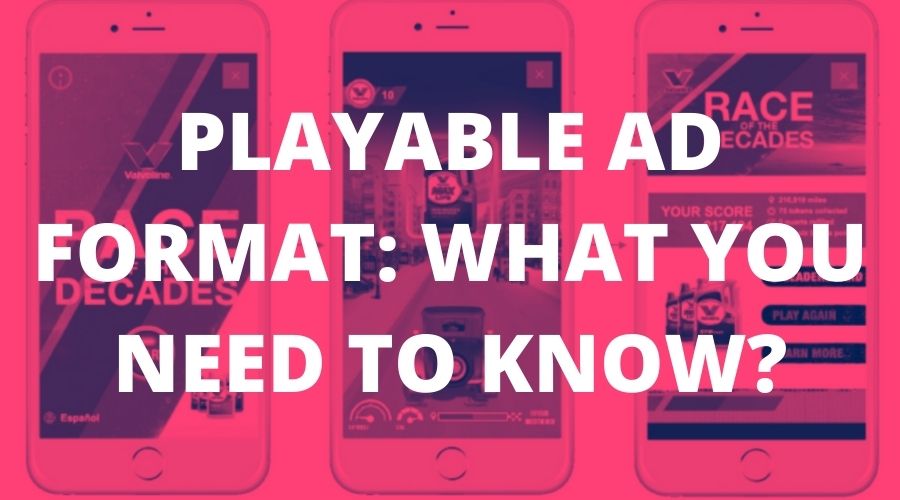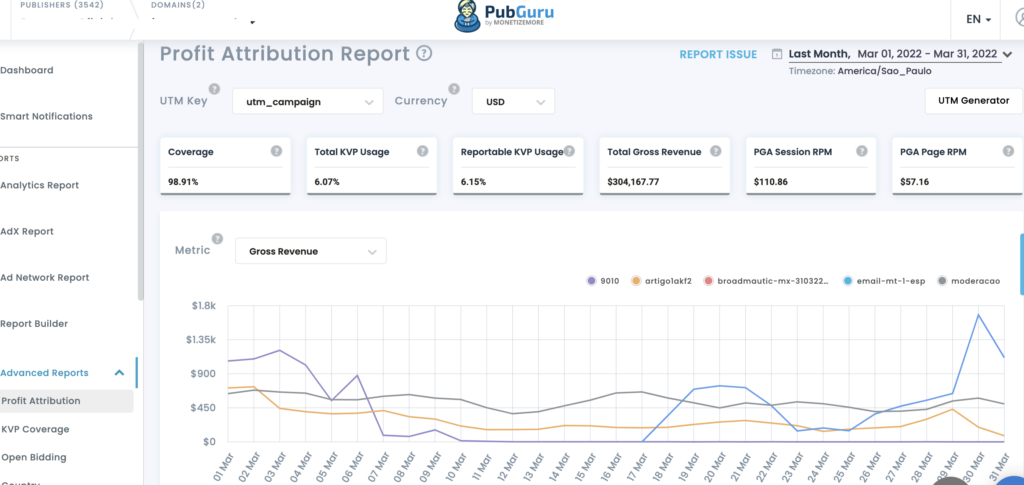
This post was most recently updated on January 18th, 2023
Advertising apps can be a daunting prospect. There are currently 4.83 million apps available to download, 1.96 million on the Apple App Store and a further 2.87 million on the Google Play Store. So how does an app publisher go about standing out from the crowd? Increasingly, over the past few years, the answer has been to utilize the playable ad format.
Typically we think of playable ads as being relevant only to mobile games. Those of us who play games on our devices have all seen them. I remember always being shown a playable ad featuring racing (below), produced by automotive oil brand Valvoline. Increasingly, however, non-gaming apps are utilizing playable ads too. Everything from apps to speed up android to language learning apps.

Playable ads are exactly what it says on the tin, they are advertisements that are playable (or in any other way interactive). They appear in much the same way as other embedded ads, such as video ads or banner ads. They are becoming the marketing form of choice for many app developers as they can offer a ‘trial’ of an app before ever being downloaded.
While of course, playable ads are directly a paid form of marketing, as they cost money to be displayed on websites and video ad networks. They are also a fantastic indirect source of affiliate marketing free traffic. This is thanks to the huge numbers of gaming streamers who, thanks to playing a playable ad, might download and stream it to their followers. Gaming streamers offer great paid and organic affiliate marketing options and shouldn’t be ignored by publishers.
The Hook – This is the default screen of the ad. It’s almost always brightly colored and accompanied by a musical tune of some description. The purpose of this screen is to grab the attention of the user and entice them into interacting with the ad.
This stage of the ad will also often feature some kind of demonstration of how the interactive element of the ad works. This is to show both how easy the ad is to interact with as well as how fun/useful the interactive element is. In the example below by Babbel, the playable mobile ads ‘hook stage’ invites users to interact with the ad and take a free Spanish lesson.

The Game – This is the bulk of the ad itself, the interactive element. This should be a representation of either how the game being advertised works or how the app functions and its benefits. The previous stage of the ad should have informed users on how to play the game and it should aim to give enjoyment to the user.
Users should be rewarded for playing the game successfully, though it shouldn’t by any stretch be challenging. This stage should be by far the bulk of the ad and should account for most of the user’s time spent engaging with it. Using the Babbel example again, you can see below how users interact with the ad by selecting the correct English translation to the Spanish word.

The Call-to-action – This stage of the playable ad is without a doubt the most important. Now users have finished interacting with the game, they should be encouraged to click through to a download page or brand information page (depending on the conversion goal of the ad).
More often than not for mobile game ads, which most playable mobile ads tend to be, this link to the app store will also offer some form of incentive to download the game. This usually relates to a boosted in-game currency, which generally has to be earned through ‘grinding’ or purchased with real money. Take a look below at Babbel’s playable ad linked through to their Apple App Store for users to download the app and get more of the content they just enjoyed in the ad.

The answer is a resounding yes!
There are so many reasons that publishers should be considering using playables and mobile ads to advertise their apps or mobile games. Read on for a breakdown of the key reasons publishers should be utilizing playables in their marketing strategy.

Let’s face it, videos that autoplay with obnoxious music or talking are the worst. It always seems to happen when we forget our volume is turned all the way up and usually when I’m browsing in bed (sorry loving partner who’s no longer asleep!).
Playable ads tend to be much less intrusive, often having a landing card that displays the content of the ad if it’s engaged with. Only once a user has interacted with the ad will it begin its cycle through the stages and then encourage the user to play the interactive element of the ad.
This non-intrusive advertising style works wonders at enticing users to engage with the content. Playable ads, by definition, are engaged with, while remaining on the page the user was already on, meaning they have the comfort of knowing they can play the game and still easily access the content they originally came for. This positive interaction establishes a degree of trust between the user and the brand and can increase conversion rates.
Playable ads allow users a trial run of what they can expect if they go ahead and download the app in question. Users being able to test out the gameplay mechanics (or user interface for non-gaming apps) is much like a person trying on a pair of pants before buying or trialing call recording software before subscribing.
This ‘try before you buy’ approach is much more effective at making conversions than video or banner ads as the interactivity builds rapport with users in a way that only watching can’t. This, coupled with the trust built through being non-intrusive, builds into a wider successful relationship marketing strategy.
So long as the playable content in the ad is a fair representation of the content in-app, users who download are much less likely to uninstall shortly afterwards. If the content in the ad does not mirror that which can be found in-app, uninstall rates can actually be even higher.
If, for example, the playable ad is showcasing features useful for communication in enterprises then those features should be accurate to those found within the app once installed. If there are marked differences between the interactive content in the ad and the current version of the app, users will feel misled and be more likely to uninstall.
It’s important to note at this point that game/app features highlighted in the ad shouldn’t only be those held behind a paywall. Showcasing paid-for elements within a free-to-download app is often poorly received by users and can also lead to more uninstalls.
More traditional forms of online advertising give surface-level data, which focuses on click-through rates. Playable ads can go far deeper than just the number of people who say it vs. the number who clicked on it, instead giving analytical information like:
Access to such diverse metrics allows publishers to figure out what is working and what isn’t about the ad and tweak it until it is as efficient at making conversions as possible. Also, analytics on offer through ‘playable ads google ones’ tend to be much more detailed than more traditional online ads such as videos or banners.

For publishers who will also be hosting a playable ad on their own website, it’s worth checking out the built-in analytic features of the Content Management System (CMS). For WordPress-built sites for example there are an array of useful advanced ad features that can be taken advantage of to pull even more data.
While there are countless obvious benefits to publishers who opt to use playable ads in their marketing strategy, there are some things to consider before putting one together. Following these best practices will allow your playable ad to be the conversion goldmine you want it to be.
An ongoing theme in this guide is that the success of facebook playable ads hinges on how accurate and honest the ad is to the app its advertising. Users aren’t expecting the ad to show every minute detail of the game in the ad, but they also aren’t expecting to be purposefully misled. The playable ad should highlight the game’s best, most enjoyable elements without making the actual game seem like the latter part of an ‘Instagram vs. Real life’ situation.
This should be an obvious point to make, yet it can be tempting to focus solely on marketing the app. Let’s say a cloud communications brand wants to raise awareness of a particular function of its service, Dialpad fax for example. It’s important that the playable ad should put this feature at the forefront of its interactive part. The ad should also maintain a professional tone to keep in line with wider brand standards.
Brand color schemes should also be adhered to when designing a playable ad so users are able to easily associate the ad with the brand. A playable ad by Coca-Cola should have a red and white color scheme, while Pepsi’s should be predominantly blue, with red and white highlights. Also, thinking carefully about the images you’re going to choose and if you want to use free stock photos or not.
Most html5 playable ads are short and sweet, so as to give an exciting peek into the app and make users want to download it. As mentioned before, the content highlighted in the ad should focus on the key USPs of the app itself. When designing a playable ad, it’s important to aim for it to give enough to leave users wanting more.
The first thing that might come to mind here is knowing the demographic that you want to market toward. While this is absolutely true, it’s worth also utilizing RFM analysis to be even more specific in your marketing. RFM based research is more targeted than traditional demographic research and focuses on recency, frequency, and (how much) money spent.
This level of research of course can be more resource-intensive, although taking the time to outline an incredibly accurate target audience can really pay dividends in terms of reaching and surpassing conversion goals.
For publishers considering making use of the playable ad format after starting a blog, it can be incredibly tempting to get lost in the excitement of the game format and forget that it is still an ad.
Just like when designing a video ad or a banner ad, it’s important to remember to stick to ad optimization best practices. A few quick examples include keeping the ad refreshed and up-to-date as well as ensuring the ad is designed to load quickly on mobile devices (which should be most of your views!).
Playable ads are successful because they tap into our inherent human desire to interact with things and to play games. It’s a no-brainer that an ad that invites us to play with it and be rewarded for doing so well is more effective and memorable than a static banner ad. You’d be hard-pressed to tell me about a banner ad you remember seeing lately, wouldn’t you?
The interactive ad format isn’t just relevant for gaming app publishers either, with Babbel’s expertly crafted try before you buy Spanish lesson ad being testament to that. For app publishers across the board, especially those struggling to stand out from the crowd, playable ads should be an integral part of a whole business transformation roadmap.
I wouldn’t be surprised to see all publishers who are serious about investing in their app using playable ads to market their product going forward. It seems likely that in the same way that Australian brands should be hosting on domain names Australia, mobile apps should be making use of playable ads.
So what are you waiting for? Get started with playable ads today with us!

Jessica Day is the Senior Director for Marketing Strategy at Dialpad, an enterprise call center software and modern business communications platform that takes every kind of conversation to the next level—turning conversations into opportunities. Jessica is an expert in collaborating with multifunctional teams to execute and optimize marketing efforts, for both company and client campaigns. Jessica Day also published articles for domains such as Kanbanize and AirDroid. Here is her LinkedIn

Paid to Publishers
Ad Requests Monthly
Happy Publishers
10X your ad revenue with our award-winning solutions.